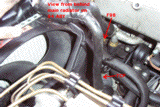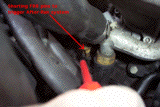|
Introduction
| 3B System
| ABY Changes
| Fault Diagnosis |
System Repair
|
||
|
Checking the After-Run Sequence and Turbo Coolant Pump (TCP)
The following has been successfully tested on an ABY motor, but it should
be applicable to the 3B ...
The simplest way to test the TCP and After-Run system is to allow the engine to idle until the radiator fan is engaged then shut the engine down by removing the ignition key. After about five minutes, as heat-soak begins to take effect, the after-run sequence should be activated. The Bentley manual for the UrS4/S6 actually suggests covering the radiator to ensure that heat soak is maximised when testing the after-run system. During the After-Run sequence the radiator fan should run at its lowest speed and the TCP motor should be running. Up to this point, every component in the after-run sequence has been tested except the TCP motor itself. Given the risks of scalding yourself or snagging something in the radiator fan it is safest NOT to try and place a hand on the TCP to 'feel' if it is running. It's impossible to hear the TCP over the racket of the radiator fan so it is best to test the TCP on a cold engine as described below. Click here for the quickest sanity check on the TCP which you can do everyday ... The following paragraphs test all the control circuitry thoroughly. |
||
|
After-Run
Test Procedure
This
procedure shouldn't take any more than a few minutes to carry out, but the
restricted access to the after-run thermoswitch (F98) makes for some annoyance
and extra time required (unless you are blessed with unfeasibly long and
thin fingers).
Remember that F98 switches on a 12V signal so be very careful, if using an ordinary metal screwdriver, not to short it on the engine as this will blow the after-run fuse. Only Audi's electrical engineers can tell you what on earth possessed them to wire the after-run control circuitry in this way - I certainly can't see any advantage. With the tip of the screwdriver held across the two pins on F98, the TCP motor can now easily be heard and felt running. Happy Days... Replace the fan relay and slide the connector hoods back onto the thermoswitch. If the TCP does not operate with the procedure decribed above then it should be tested in isolation. Firstly check that 12V is permanently apparent on one of the pins on the TCP connector plug. If not then there is most likely a problem in the loom. Secondly, remove the TCP/After-Run relay from its location in the auxiliary relay carrier and connect the pins on the connector destined for terminals 6 and 8 (six and eight) together. This forces 12V across the TCP, so if it doesn't run now it should be replaced. Before ordering an expensive new TCP it is wise to double check the wiring loom by placing a 12V bulb across the TCP connector pins. This should illuminate when pins 6 and 8 at the J155 relay carrier are tied together. |
||
|
TCP Sanity Check I had
to follow the above procedure to isolate the sound of the TCP running before
I twigged this one - Every time the ignition key is turned on, the TCP is
activated for about five seconds.
Many S2 owners assume this whirring noise is the fuel system being primed, but now you know ! This serves as a quick functional test of the TCP and its control relay. This sequence does NOT test the all important thermoswitch which engages the after-run cycle but it is a good sanity check. |
Last Updated 9th November 2002

